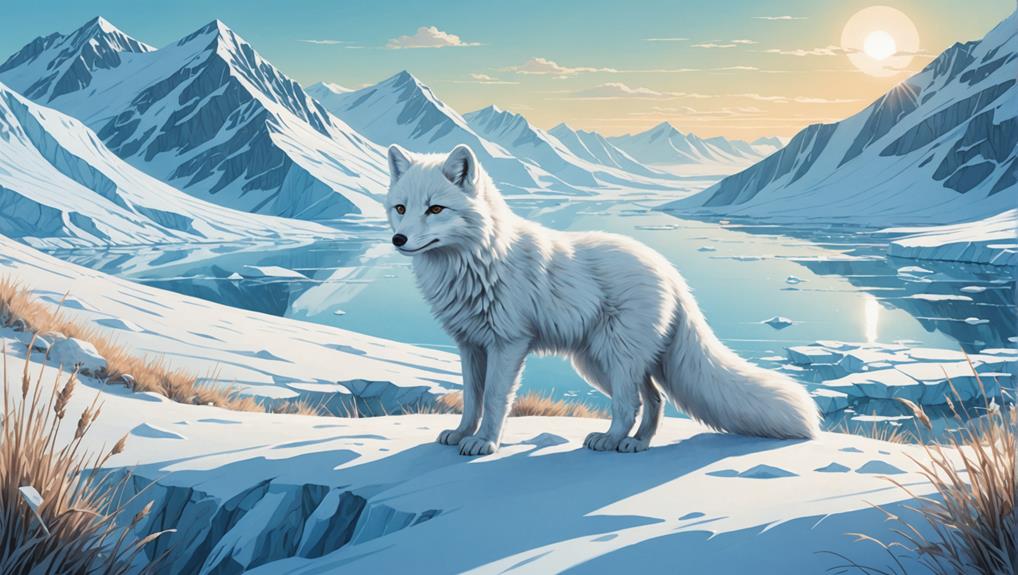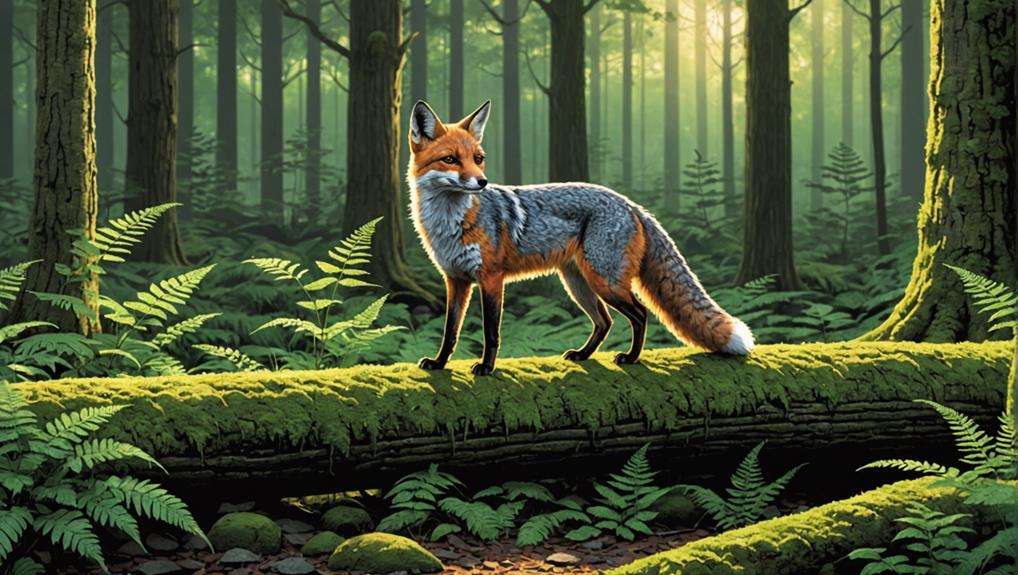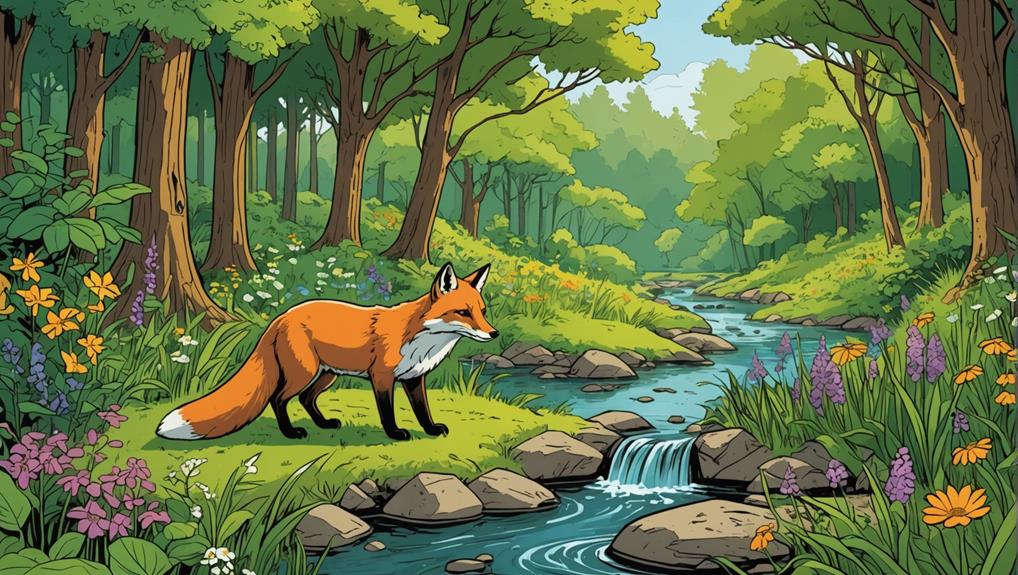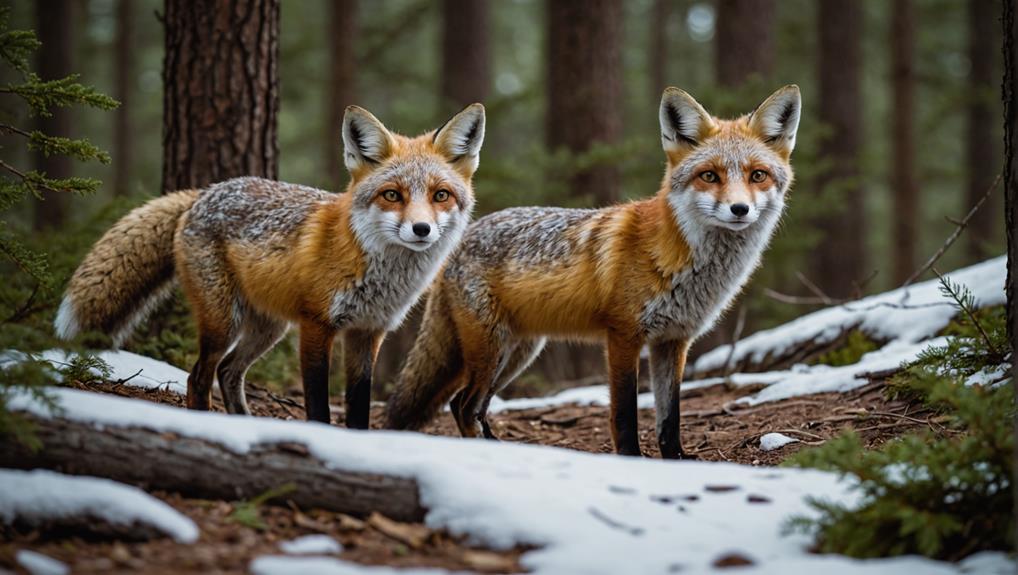Get ready to explore the world of unique fox species! From the clever red fox, which can adapt to city life, to the Arctic fox with its winter coat, these animals are truly remarkable. You've also got the tiny fennec fox with its big ears, perfect for desert antics, and the gray fox, known for its impressive tree-climbing skills. And let's not forget the endangered ones like the Sierra Nevada red fox. Each species has its own habitat and quirks, making them all the more special. Stick around, and you'll discover even more about these charming creatures!
Contents
Overview of Fox Diversity
Diving into the world of fox diversity, you'll discover that these fascinating creatures belong to the Canidae family, with around 27 extant species spread across the globe.
Among these, the red fox (*Vulpes vulpes*) stands tall as the largest true fox species. It boasts over 45 recognized subspecies, adapting to various climates from North America to Europe and Asia.
But it's not just the red fox that captivates; meet the petite fennec fox (*Vulpes zerda*), a tiny desert dweller that weighs only 1 to 1.3 kg! These little guys thrive in diverse habitats, showcasing the adaptability of true foxes.
Unfortunately, some fox species face urgent conservation concerns. The Sierra Nevada red fox, with fewer than 50 individuals left, highlights the plight of endangered species.
Meanwhile, Darwin's fox (*Lycalopex fulvipes*) teeters on the brink of extinction with just 639 left in the wild.
Foxes often live in small family groups, emphasizing their social nature.
The Red Fox
The red fox (*Vulpes vulpes*) stands out among its kin as the largest true fox species, showcasing a stunning reddish-orange coat that captures the eye. You'll find these clever creatures thriving in diverse habitats across North America, from lush forests to bustling urban areas. Their adaptability is truly remarkable!
Red foxes sport a beautiful reddish-brown coat, often adorned with black ears and feet, making them easy to spot. As omnivores, their diet is varied and includes small mammals, birds, insects, and even fruits. They're not picky eaters, and their eating habits shift with the seasons based on what's available.
During breeding season, which runs from December to April, a breeding pair typically raises three to six kits together, showcasing their teamwork. The gestation period lasts about 52 days, leading to a busy but joyful time for these furry families.
While their average lifespan in the wild is around 3 to 5 years, some can live up to 15 years in captivity.
The Arctic Fox

With its striking adaptations to frigid climates, the Arctic fox (*Vulpes lagopus*) is a remarkable survivor of the tundra. You'll be amazed at how this small creature thrives in cold environments. Weighing between 3 to 8 kg (6.5-17 lbs), its appearance changes with the seasons. In winter, its thick white coat camouflages it perfectly against the snow, while in summer, it dons a brown or gray coat to blend in with the tundra landscape.
The Arctic fox has a wide geographic distribution, found across the Arctic regions of North America, Europe, and Asia. You can often spot them in places like Iceland and Svalbard.
These clever foxes are known for their scavenging behavior, preying on small mammals like lemmings and birds, and they don't shy away from nibbling on carrion or plants when the pickings are slim.
During the breeding season, you'll find solitary individuals, but in summer, they form family groups. After a gestation period of about 52 days, the proud parents care for their adorable kits in cozy dens, ensuring the next generation of these resilient foxes continues to thrive.
The Fennec Fox
Let's talk about the Fennec fox, the tiniest member of the fox family that's got some seriously cute features!
These little guys have giant ears that not only help them hear a pin drop in the desert but also keep them cool under the scorching sun.
Living in family groups, they've mastered the art of surviving in their sandy home, proving that even in tough conditions, there's always a way to adapt and thrive!
Physical Adaptations and Features
Although you might think of foxes as similar in appearance, the Fennec fox showcases remarkable physical adaptations that set it apart. This tiny creature, weighing just 1 to 1.3 kg, is famous for its distinct, large ears that can grow up to 15 cm long. These ears not only look adorable but also help the fox dissipate heat and hear prey underground.
The Fennec fox's sandy-colored coat provides excellent camouflage in its desert habitat, reflecting sunlight during the day while keeping it warm at night. Plus, its specially adapted feet protect it from scorching sands—talk about nature's little miracle!
Here's a quick overview of some of its features:
| Feature | Description | Purpose |
|---|---|---|
| Large Ears | Up to 15 cm in length | Heat dissipation and acute hearing |
| Sandy Coat | Light-colored fur | Camouflage in desert environments |
| Adapted Feet | Thick pads on paws | Insulation from hot sand |
| Keen Hearing | Exceptional auditory capabilities | Detecting prey underground |
| Sand Bathing | Digging holes in the sand | Cooling down and regulating body temperature |
These adaptations make the Fennec fox a true desert survivor!
Habitat and Behavior Insights
The Fennec fox thrives in the harsh conditions of the Sahara Desert, showcasing impressive adaptations that allow it to survive in one of the most extreme environments on Earth. This small fox, native to the arid desert regions of North Africa, weighs only about 1 to 1.3 kg and has a sandy-colored coat that blends perfectly with its surroundings—talk about camouflage!
Being primarily nocturnal, the Fennec fox comes alive at night, hunting for insects, small mammals, and fruits during the cooler hours. It's like having a midnight snack, but in the wild!
Their burrowing behavior is fascinating too. They dig deep, reaching up to 3 meters, creating cozy dens that shield them from the scorching sun and pesky predators.
Social creatures at heart, Fennec foxes live in small family groups and communicate with an array of vocalizations—think barks, whines, and even purring. It's a lively chatter that keeps their bonds strong.
The Gray Fox

Let's talk about the gray fox, a fascinating creature that's as comfortable in trees as it's on the ground!
With its slender build and unique wrist adaptations, this little climber thrives in wooded areas, where it scampers around looking for food and avoiding predators.
You'll find that its playful behavior and vocalizations add to its charm, making the gray fox a truly special member of the fox family.
Habitat and Distribution
Spanning from southern Canada to northern South America, gray foxes (*Urocyon cinereoargenteus*) thrive in a variety of habitats, particularly those rich in dense vegetation.
These clever creatures love woodlands, scrublands, and chaparral, where they can find plenty of cover and cozy denning sites. Imagine a little fox peeking out from behind some bushes—adorable, right?
What sets the gray fox apart from other fox species in North America is its unique ability to climb trees. Yes, you read that right! They use their special wrist adaptations to escape predators or nab a snack high up in the branches.
Their territories can stretch from 1 to 3 square miles, depending on how lush their surroundings are.
Interestingly, gray foxes don't shy away from urban areas either. You might spot one sneaking through gardens or exploring green spaces in your neighborhood.
They've adapted well to suburban life, proving they can balance their wild instincts with city living. So, next time you see a gray fox darting through the bushes, remember they're just trying to make the best of their habitat, whether it's deep woods or your backyard!
Physical Characteristics
Gray foxes are striking creatures, showcasing a blend of agility and charm. Weighing between 7 to 12 pounds, these little marvels have a stocky body and an impressive body length of 28 to 42 inches, including a bushy tail that can add another 12 to 16 inches.
Their fur color varies, often a lovely grayish-brown with reddish hues on the sides and legs, which helps them camouflage beautifully in their woodland habitats.
Unlike red foxes, gray foxes have a unique feature: specialized wrist bones that grant them the ability to climb trees! Imagine that—a fox scaling a tree like a furry acrobat.
Their darker stripe along the back, often subtle compared to other species, further enhances their camouflage skills. This adaptation allows them to blend seamlessly into their surroundings, making them masters of disguise.
Behavioral Adaptations
Among the many fascinating traits of the gray fox, its climbing ability stands out as a remarkable behavioral adaptation. Imagine this clever member of the fox family scaling trees, escaping predators, and even reaching food sources that are out of reach for other canids. It's not just a party trick; it's a survival skill!
Despite their cunning nature, gray foxes tend to be solitary. They've a flexible social structure, overlapping home ranges that allow them to thrive without relying heavily on a pack.
Their adaptable diet is another impressive feature, as they feast on small mammals, birds, fruits, and even invertebrates. This flexibility helps them live comfortably in various habitats, from woodlands to urban areas.
With their grayish coats and reddish patches, these foxes have mastered camouflage, blending seamlessly into their environments.
They've got a lot to say too! Gray foxes communicate using a range of vocalizations—barks, screams, and yips—to establish territory and maintain connections.
Lesser-Known Fox Species
Discovering lesser-known fox species reveals a fascinating world of biodiversity that often goes unnoticed. Take Darwin's Fox, for instance. This critically endangered species, with only around 639 individuals left, calls Chiloe Island in Chile home. Unfortunately, it faces severe habitat loss and threats from introduced species.
Then there's the Sierra Nevada Red Fox, an endangered subspecies with fewer than 50 remaining. You'll find it in California's high mountains, where it bravely battles against habitat fragmentation and climate change.
Don't overlook the elusive Cozumel Fox, which has barely been documented. With its survival hinging on tourism and habitat preservation, every sighting counts!
The Kit Fox, known for its large ears and playful nature, prowls the southwestern U.S. and northern Mexico, snacking on small mammals and insects in the arid climate.
Lastly, the Corsac Fox showcases its social behavior by hunting in groups across the steppes of Central Asia.
Conservation Efforts for Foxes

Conservation efforts for foxes are crucial in safeguarding their future, particularly for endangered species like Darwin's fox and the Sierra Nevada red fox. These furry little friends need our help!
Conservation programs focus on habitat protection, population monitoring, and reducing human impacts. By working together with local communities, we can educate others about foxes and find ways to limit human-wildlife conflicts, especially with urban red fox populations that may be causing a ruckus.
Captive breeding programs play a vital role, too. They aim to boost the numbers of critically endangered species so they can be reintroduced into their natural homes. It's like sending them off to a grand reunion!
Habitat preservation is essential for maintaining genetic diversity and ensuring ecological balance. Many fox species depend on specific environments to thrive.
Plus, hunting restrictions and habitat management initiatives set by federal and state regulations provide a solid legal framework for protecting these adorable creatures.
Final Thoughts
So, there you have it! Foxes are fascinating creatures, each with their own unique traits and habitats. From the clever red fox to the adorable fennec fox, these little guys remind us of nature's wonders. But they need our help to thrive! By supporting conservation efforts, you can be a part of protecting these amazing animals and their homes. Let's work together to ensure future generations can enjoy the charm of foxes just as we do today!














